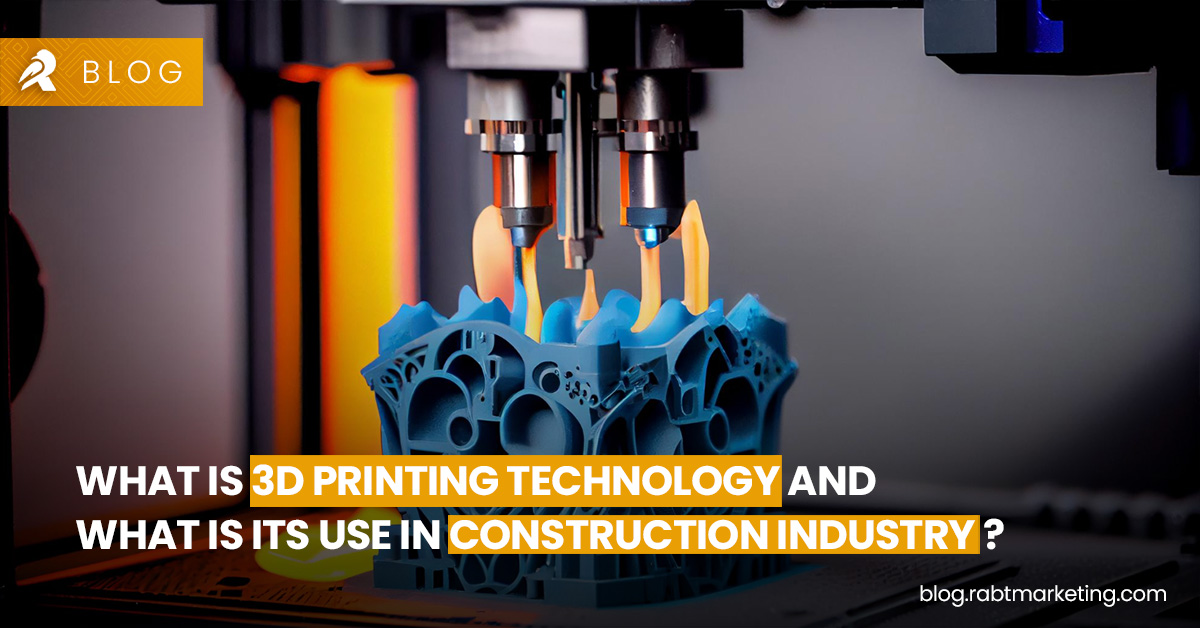3D Printing is a new and innovative technology evolving the trends and shape of construction industry. It is a revolutionary concept that uses computer-controlled additive manufacturing processes to create three-dimensional structures. It is also known as 3D construction printing (3DCP) or additive manufacturing (AM) construction.
3D printers in construction work by depositing material layer by layer to build up a structure. The material can be concrete, metal, plastic, or other materials. The printer is controlled by a computer program that reads a digital model of the structure and tells the printer how to deposit the material.
How 3D Printing is used in Construction Industry?
3D printing, also known as additive manufacturing, is a process that involves creating three-dimensional objects by layering materials on top of each other. This technology has gained immense popularity in various sectors, including aerospace, healthcare, and automotive. Now, it’s making its mark in the construction industry.
Construction 3D printers, often called C3DP, are special machines used to create buildings. The process begins with a computer model of the structure we want to build. This model is sliced into many thin layers, like cutting a cake into slices. Then, a robot or a large machine follows a set path to put down each layer of material. It’s like making a sandwich with layer after layer of ingredients. This continues until the whole building is finished. Materials like concrete, metal, or special plastics are used to create these 3D structures.
The most common way to 3D print a building is by using a robot arm that squirts out concrete while it moves. There are other methods too. One of them involves turning layers of powder into a solid object, kind of like turning loose sand into a sandcastle. Another method uses welding to create metal objects. In one case, they even 3D printed a whole bridge in Amsterdam!
So far, 3D printing has been used to make houses, offices, and many other kinds of buildings.”
Applications of 3D Printing in Construction
Housing Construction
3D printing is revolutionizing housing construction. Companies like ICON and Apis Cor have developed large-scale 3D printers capable of building houses quickly and cost-effectively. This method not only speeds up construction but also reduces material waste, making it a more sustainable option.
Architectural Components
Complex architectural components, such as decorative facades, columns, and intricate molds, can be created with high precision using 3D printing. This opens up new possibilities for architects and designers to create unique and aesthetically pleasing structures.
Infrastructure
Bridges, tunnels, and even emergency shelters can be constructed using 3D printing technology. The flexibility of the materials used in 3D printing allows for the creation of structures that are durable and adaptable to various environmental conditions.
Repair and Maintenance
3D printing is also being used for repair and maintenance tasks in the construction industry. It allows for the creation of custom replacement parts for machinery and equipment, reducing downtime and costs.
Read Also:- What is Building Information Modeling BIM and How it is Shaping the Construction Industry ?
Benefits of 3D Printing in Construction
Cost-Effective
Traditional construction methods often lead to cost overruns and delays. 3D printing reduces labor costs, material waste, and construction time, resulting in significant cost savings.
Faster Construction
3D printers work 24/7, producing structures at a consistent pace. This efficiency is especially beneficial in disaster recovery scenarios, where rapid construction is crucial. 3D-printed structures are also lightweight, making them ideal for temporary structures or in remote areas. Additionally, they are more sustainable, as they use less material than traditional construction methods.
Design Freedom
Architects and designers have greater freedom to experiment with intricate designs, as 3D printing can create complex shapes and structures that would be challenging or impossible using traditional construction methods.3D-printed structures are also lightweight, making them ideal for temporary structures or in remote areas.
Sustainability
By reducing material waste and minimizing the environmental impact, 3D printing is considered a more sustainable construction method. 3D printing can also be used to create structures that can withstand extreme weather conditions. They are more sustainable, as they use less material than traditional construction methods
Customization
3D printing allows for high levels of customization. Builders can create structures tailored to specific needs and requirements, whether it’s for housing, commercial buildings, or infrastructure.
Disadvantages and Difficulties in 3D Printing
While 3D printing has its advantages in the construction industry, there are also some disadvantages or difficulties associated with its use.
Costly Investment
Getting a 3D printer can be really expensive. And moving these big machines to construction sites isn’t easy. Besides the initial cost, you need to spend money on materials and keeping the printer in good shape. For many builders, it’s hard to justify the expense.
Deficiency of Skilled Workers
The construction industry is growing, but there aren’t enough skilled workers. 3D printing needs even more specialized skills, which can be tough to find. So, finding the right people to operate 3D printers is a challenge.
Quality Control
3D printing can make complex and custom stuff, but it’s tricky to ensure the quality. In regular construction, supervisors check the work, but 3D printing is automatic. The quality depends on how accurate the printer is and the materials used. Meeting the industry’s material standards can also be tough since there aren’t universal quality checks yet.
Regulations Are Unclear
There aren’t clear rules for 3D printing in construction. This lack of government oversight is a problem for adopting the technology quickly. It’s also hard to update building codes to include new tech. The goal is to have the same rules for 3D printing construction across all places, but that will take time and effort.”
Material Selection
Identifying and optimizing suitable construction materials for 3D printing can be a complex task. It is important to consider the mechanical properties of the materials, such as strength and stiffness, as well as the environmental impact of the material. Additionally, the cost and availability of the material must also be considered.
Regulatory Hurdles
Many countries and regions lack clear regulations for 3D printing in construction, which can hinder widespread adoption. The lack of regulations makes it difficult to guarantee the quality of 3D-printed structures.
Scalability
Expanding 3D printing construction projects to meet the demands of large-scale developments is a logistical challenge that must be overcome.
Types of 3D Printing in Construction
In construction, we use two main types of 3D printing technology: robotic arms and gantry systems. Let’s look at each of them:
Gantry System
Gantry-style printers are the most common type of 3D printer used in construction. They work by moving a print head back and forth over a platform to deposit material. Gantry-style printers are typically used to build large structures, such as houses and bridges.
A gantry 3D printer in construction is big and uses a gantry system to move the printing head in three directions: up and down, left and right, and forward and backward. These printers are often put on rails or tracks to make sure they move very precisely. They’re great for printing large objects like buildings. Gantry 3D printers are also known for being stable and cost-effective.
Robotic Arm Extruders
Robotic arm extruders are similar to cranes. They move around and release materials like concrete or plastics layer by layer to build a 3D structure. These robotic arms are guided by special computer software that tells them where to put the material. They follow a specific pattern to create the shape and thickness needed.
Robotic arm printers are less common than gantry-style printers, but they are becoming more popular. Robotic arm printers work by moving a print head in three dimensions to deposit material. This gives them more flexibility than gantry-style printers, but they are also more expensive.
Methods of 3D Printing in Construction
When it comes to 3D printing in construction, there are different techniques to choose from, and each has its own strengths and weaknesses. Here are some common methods:
Extrusion:
This is the most common method. It works by pushing materials through nozzles on robotic arms, gantry systems, or cranes. It’s used for various purposes, like creating models, prototypes, and real parts.
Powder Bonding:
Instead of using solid materials, this method uses powdered substances as the primary material. There are two types: powder bed jetting and binder jetting. In powder bed jetting, a laser melts the material to make each layer, adding more for the next layer. In binder jetting, a liquid binding agent is sprayed onto the powder, sticking the particles together layer by layer. This method is precise and can handle detailed prints.
Spray:
In this method, a separate robot sprays building materials in layers to create the desired shape. It leaves gaps that can be filled with concrete. Researchers are exploring this method for making vertical parts and decorative features like facades and ceiling decorations.
Sand Layers:
With this method, layers of sand are released to create a structure. The printer drops tiny amounts of a binding agent onto the sand grains, making them stick together. This technique is good for making small structures or parts. It’s affordable and doesn’t need highly specialized equipment like some other 3D printing methods.
Conclusion
3D printing in the construction industry represents a transformative shift in the way we build. Its numerous applications, cost-saving benefits, and potential for innovation make it a game-changer. As technology continues to evolve and regulations adapt, 3D printing will become an integral part of the construction industry, offering unique and sustainable solutions to meet the demands of our rapidly changing world. The future of construction is taking shape, one layer at a time.

